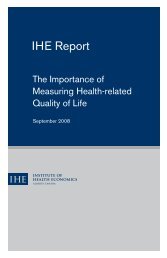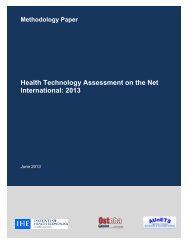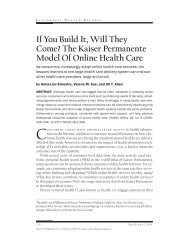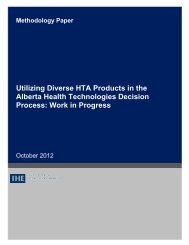Bariatric treatments for adult obesity - Institute of Health Economics
Bariatric treatments for adult obesity - Institute of Health Economics
Bariatric treatments for adult obesity - Institute of Health Economics
- No tags were found...
Create successful ePaper yourself
Turn your PDF publications into a flip-book with our unique Google optimized e-Paper software.
Table T.F.1-4: Weight loss – SurgerySurgeryKlarenbach et al., 2010 38Studies comparing surgery withanother surgery or standardcare:N <strong>of</strong> trials: 31N <strong>of</strong> pts: NA; mean BMI rangedfrom 42 to 58 kg/m 2Studies comparinglaparoscopic with open surgery:N <strong>of</strong> trials: eightN <strong>of</strong> pts: NA; mean BMI rangedfrom 42 to 51 kg/m 2Weight lossSurgery versus another surgery or standard care (diet and exercise)At 1 year (15 trials, 1103 pts):Network analysis:* Ranking <strong>of</strong> the effectiveness <strong>for</strong> reducing BMI (from most to least efficacious): JB, loop gastric bypass, mini-gastric bypass,BPD, sleeve gastrectomy, RYGB, HG, VBG, AGB, and standard care.Network analysis: RYGB produced significantly greater decreases in BMI from baseline than did AGB (MD 6.6; 95% CrI:**: 9.5 to 3.4) andstandard care (MD 8.6; 95% CrI: 1.6 to 2.2); direct evidence supported the findings <strong>of</strong> network analysis <strong>for</strong> RYGB versus AGB (MD 5.8;95% CI: 9.7 to 1.9; 2 trials), although statistical heterogeneity was large.At 2 years (10 trials, 813 pts):Ranking <strong>of</strong> efficacy by network analysis: JB, BPD, mini-gastric bypass, AGB with omentectomy, RYGB, HG, VBG, and AGB.Network analysis: RYGB produced significantly greater decreases in BMI than did VBG (MD 4.1; 95% CrI:7.0 to 1.9] and AGB (MD 8.0;95% CrI: 10.9 to 5.1); direct evidence was available and supportive <strong>for</strong> RYGB versus VBG (4.7; 95% CI: 6.1 to 3.2; 3 trials), and RYGBversus AGB (7.2; 95% CI: 8.9 to 5.5; 1 trial)No BMI data were available at 2 years <strong>for</strong> loop gastric bypass, sleeve gastrectomy, HG, gastrogastostomy, or standard care.At 3 to 5 years (seven trials, 416 pts):Ranking by network analysis: similar to year 1 and year 2: JB, RYGB, VBG, AGB.Network analysis: RYGB produced significantly greater decreases in BMI from baseline than did AGB (MD 7.7; 95% CrI: 15.1; 0.01); directevidence was available and supportive <strong>for</strong> RYGB versus AGB (6.4; 95% CI: 7.9 to 4.9; 2 trials); no other result from network analysis wassignificant.No data were available during this period <strong>for</strong> BPD, loop gastric bypass, mini-gastric bypass, AGB with omentectomy, gastrogastostomy, orsleeve gastrectomy.Laparoscopic versus open approachesAt 1 year (five trials, 234 pts):Small but significantly greater decrease in BMI in the laparoscopic surgery group as compared to the open surgery group (MD 1.2 kg/m 2 ; 95%CI: 2.2 to 0.2; five trials)Two trials reported changes in BMI between three and five years; the difference was not statistically significant.* Network analysis: pooling data from studies that are not directly compared but are linked via one or more common comparators.** Credible interval (CrI): used <strong>for</strong> mixed (direct and indirect) and indirect evidence<strong>Bariatric</strong> <strong>treatments</strong> <strong>for</strong> <strong>adult</strong> <strong>obesity</strong> 140
















